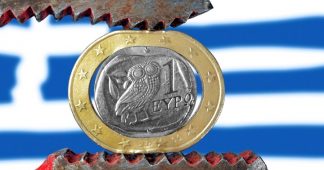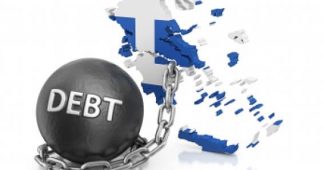Photo: Hermann Josef Abs signing the London agreement canceling German foreign debt on 27 February 1953.
By Eric Toussaint
Mar. 27, 2018
In 2020, the World Bank (WB) and the IMF will be 76 years old. These two international financial institutions (IFI), founded in 1944, are dominated by the USA and a few allied major powers who work to generalize policies that run counter the interests of the world’s populations.
The WB and the IMF have systematically made loans to States as a means of influencing their policies. Foreign indebtedness has been and continues to be used as an instrument for subordinating the borrowers. Since their creation, the IMF and the WB have violated international pacts on human rights and have no qualms about supporting dictatorships.
A new form of decolonization is urgently required to get out of the predicament in which the IFI and their main shareholders have entrapped the world in general. New international institutions must be established. This new series of articles by Éric Toussaint retraces the development of the World Bank and the IMF since they were founded in 1944. The articles are taken from the book The World Bank: a never-ending coup d’état. The hidden agenda of the Washington Consensus, Mumbai: Vikas Adhyayan Kendra, 2007, or The World Bank : A critical Primer Pluto, 2007.
If West Germany could redeem its debt and rebuild its economy so soon after WWII it was thanks to the political will of its Western creditors who had won the Second World War, i.e. the United States and their main Western allies (the United Kingdom and France). In October 1950 these three countries drafted a project in which the German federal government acknowledged debts incurred before and during the war. They added a declaration to the effect that “the three countries agree that the plan include appropriate satisfaction of demands towards Germany so that its implementation does not jeopardize the financial situation of the German economy through unwanted repercussions nor has an excessive effect on its potential currency reserves. The first three countries are convinced that the German federal government shares their view and that the restoration of German solvability includes an adequate solution for the German debt which takes Germany’s economic problems into account and makes sure that negotiations are fair to all participants.” [1]

Series: 1944-2020, 76 years of interference from the World Bank and the IMF (Part 6)
Why the 1953 cancellation of German debt won’t be reproduced for Greece and Developing Countries
27 March by Eric Toussaint
 Hermann Josef Abs signing the London agreement canceling German foreign debt on 27 February 1953.
Hermann Josef Abs signing the London agreement canceling German foreign debt on 27 February 1953.
In 2020, the World Bank (WB) and the IMF will be 76 years old. These two international financial institutions (IFI), founded in 1944, are dominated by the USA and a few allied major powers who work to generalize policies that run counter the interests of the world’s populations.
The WB and the IMF have systematically made loans to States as a means of influencing their policies. Foreign indebtedness has been and continues to be used as an instrument for subordinating the borrowers. Since their creation, the IMF and the WB have violated international pacts on human rights and have no qualms about supporting dictatorships.
A new form of decolonization is urgently required to get out of the predicament in which the IFI and their main shareholders have entrapped the world in general. New international institutions must be established. This new series of articles by Éric Toussaint retraces the development of the World Bank and the IMF since they were founded in 1944. The articles are taken from the book The World Bank: a never-ending coup d’état. The hidden agenda of the Washington Consensus, Mumbai: Vikas Adhyayan Kendra, 2007, or The World Bank : A critical Primer Pluto, 2007.
If West Germany could redeem its debt and rebuild its economy so soon after WWII it was thanks to the political will of its Western creditors who had won the Second World War, i.e. the United States and their main Western allies (the United Kingdom and France). In October 1950 these three countries drafted a project in which the German federal government acknowledged debts incurred before and during the war. They added a declaration to the effect that “the three countries agree that the plan include appropriate satisfaction of demands towards Germany so that its implementation does not jeopardize the financial situation of the German economy through unwanted repercussions nor has an excessive effect on its potential currency reserves. The first three countries are convinced that the German federal government shares their view and that the restoration of German solvability includes an adequate solution for the German debt which takes Germany’s economic problems into account and makes sure that negotiations are fair to all participants.” [1]

- The treaty was signed by the Federal Republic of Germany, the USA, Belgium, Canada, Ceylan, Denmark, France, Spain, the United Kingdom, Greece, Ireland, Liechtenstein, Luxembourg, Norway, Pakistan, Sweden, Switzerland, the Union of South Africa and Yugoslavia.
Now Nazi Germany had suspended external debt payments from 1933 and never resumed them, which did not prevent it from receiving financial support and doing business with big private companies such as Ford who financed the launch of the Volkswagen (the people’s car imagined during the Hitler regime), General Motors who owned the firm Opel and General Electric, an associate of AEG (German General Electric) and IBM, accused of having supplied the technology that contributed to persecution, suffering and genocide before and during World War II. [2]
Germany’s pre-war debt amounted to 22.6 billion marks including interest. Its post-war debt was estimated at DM 16.2 billion. In the agreement signed in London on 27 February 1953 [3] these sums were reduced to DM 7.5 billion and DM 7 billion respectively. [4] This amounts to a 62.6 % reduction.
The sums mentioned above do not include debt linked to the policy of aggression and destruction that Nazi Germany conducted during the Second World War, nor the reparations that countries who fell victim to this aggression are entitled to. Those war debts were left aside, adding yet another enormous gift to Western Germany.
The agreement further set up the possibility to suspend payments and renegotiate conditions in the event that a substantial change limiting the availability of resources should occur. [5]
To make sure that the West German economy was effectively doing well and represented a stable key element among NATO countries against the Eastern bloc, allied creditors granted the indebted German authorities and companies major concessions that far exceeded debt relief. Major German industrial corporations such as AEG, Siemens, IG Farben (AGFA, BASF, Bayer and Hoechst), Krupp, Volkswagen, BMW, Opel, Mercedes Benz and also top finance companies such as Deutsche Bank, Commerzbank and the insurance company Allianz were protected and reinforced despite the fact that they had played a leading role in supporting the Nazi regime and were accomplices in the genocide of the Jewish and Romani peoples. The power of Big German capital came out of WWII unscathed thanks to the support of the major Western powers.
As regards the problem of the debt that could have been demanded of Germany, the Allies took the position that the country’s economy had to be able to pay everything back while maintaining a high level of growth and improving the living standards of its population. For Germany to be able to pay back without getting poorer, it needed to benefit from debt cancellation on a large scale. But that would not be enough. As history showed, the country needed to regain considerable room for maneuver and autonomy. To achieve this creditors accepted: First, that Germany should repay a large part of its debts in its national currency (the mark), and only marginally in strong currencies such as dollars, Swiss francs, pounds sterling. Second, while in the early 1950s, the country still had a negative trade balance (importing more than it exported), they agreed that Germany should reduce importations: it could manufacture at home those goods that were formerly imported. In allowing Germany to replace imports by home-manufactured goods, creditors agreed to reduce their own exports to this country. As it happened, for the years 1950-1, 41% of German imports came from Britain, France and the United States. If we add the share of imports coming from other creditor countries that participated in the conference (Belgium, Netherlands, Sweden and Switzerland) the total amount reached 66%. Third, creditors allowed Germany to sells its products abroad and even supported such exports so as to restore a positive trade balance. These elements are all present in the aforementioned agreement: “The payment capacity of Germany’s private and public debtors does not signify only the capacity to regularly meet payment deadlines in DM without triggering an inflation process, but also that the country’s economy could cover its debts without upsetting its current balance of payments. To determine Germany’s payment capacity we have to envisage a number of issues, namely, 1. Germany’s future productive capacity with special consideration for the production of export commodities and of import substitution; 2. the possibility for Germany to sell German goods abroad; 3. probable future trade conditions; 4. economic and tax measures that might be required to insure a surplus in exports.” [6]
Moreover, in case of dispute with creditors, German courts were declared competent. It was said explicitly that in some cases ‘German courts may refuse to enforce a decision of a foreign court or of an arbitral body,’ for instance when the enforcement of the decision would be contrary to public policy’ (Agreement on German External Debts, Article 17, (4)).
Another significant aspect was that the debt service depended on how much the German economy could afford to pay, taking the country’s reconstruction and the export revenues into account. The debt service/export revenue ratio was not to exceed 5%. This meant that West Germany was not to use more than one twentieth of its export revenues to pay its debt. In fact it never used more than 4.2% (except once in 1959). In any case, since a large portion of the German debts were paid in Deutsche Marks, the German central bank could issue money, or in other words monetize the debt.
Another exceptional measure was that interest rates were substantially reduced (between 0 and 5%).
A benefit of huge economic value was granted by Western powers to West Germany: article 5 of the London agreement postpones the payment of war debts and reparations (WWI and WWII) owed by the Federal Republic of Germany to attacked, occupied or annexed countries (and to their citizens).
Finally we have to consider the dollar grants the United States made to West Germany: USD 1,173.7 million as part of the Marshall Plan from 3 April 1948 to 30 June 1952 (i.e. about USD 12.5 billion at today’s value -2019-) with at least 200 million added from 1954 to 1961 (about USD 2 billion in 2019), mainly via USAID.
Thanks to such exceptional conditions the West German economy was able to recover very fast and eventually absorbed East Germany in the early 1990s. It is now by far the strongest economy in Europe.
Some elements towards a comparison
It is enlightening to compare the way post-war West Germany was treated with the treatment of developing countries. Although bruised by war, Germany was economically stronger than most developing countries today. Yet it received in 1953 what is currently denied to developing countries.
Proportion of export revenues devoted to paying back the debt
Germany was allowed not to spend more than 5% of its export revenues to pay back its debt.
In 2017 Developing Countries had to spend an average of 14% of their export revenues on debt repayment. [7]
For countries in Latin America and the Caribbean this figure reached 23.5%. There follow some examples of countries including Developing Countries and peripheral European economies: in 2017, the figure reached 13% for Angola, 36% for Brazil, 15% for Bosnia, 21% for Bulgaria, 41.6% for Colombia, 17% for the Republic of Côte d’Ivoire, 21% for Ethiopia, 28. % for Guatemala, 34% for Indonesia, 70% for Lebanon, 14% for Mexico, 20% for Nicaragua, 22.8% for Pakistan, 21 % for Peru, 22% for Rumania and Serbia, 17% for Tunisia and 40% for Turkey.
Interest rates on external debt
As stipulated in the 1953 agreement about Germany’s debt the interest rate was between 0 and 5%.
By contrast, the interest rates to be paid by Developing Countries were much higher. A large majority of agreements had rates that could be increased.
Between 1980 and 2000, for the Developing Countries as a whole, the average interest rate oscillated between 4.8 and 9.1% (between 5.7 and 11.4 % in the case of Latin America and the Caribbean, and as much as 11.9% in the case of Brazil, between 1980 and 2004). Then interest rates dipped to a historic low during the period 2004-2015. However the situation has been worsening since 2016-2017 as the rising interest rate fixed by the Fed (the Fed’s Prime Rate went from 0.25% in 2015 to 2.25% in November 2018) and Donald Trump’s generous tax breaks to major United States companies are drawing capital back to the USA. At the same time, the prices of raw materials are showing a tendency to fall thus reducing the revenues of Developing Countries that export primary commodities. This makes it even more difficult for them to repay their debts as payments are principally made in dollars or other hard currencies. In 2018, a new debt crisis hit countries such as Argentina, Venezuela, Turkey, Indonesia, Nigeria and Mozambique. In 2019, more and more Developing Countries have to accept interest rates of over 7%, up to as much as 10%, if they wish to borrow.
Currency in which the external debt had to be paid
Germany was allowed to use its national currency to repay part of its debt.
No Developing Countries can do the same except in exceptional cases for ludicrously small sums. All major indebted countries must use strong currencies (dollars, euros, yens, Swiss francs, pounds sterling).
Possibility of revising the agreement
In the case of Germany, the London Debt Agreement set up the possibility to suspend payments and renegotiate conditions in the event that a substantial change should curtail available resources.
Creditors make sure that loan agreements with Developing Countries do not include such a possibility. Worse still, if a Developing Country should run into difficulty, creditors are allowed to demand advance payment of sums due in the future.
Policy of import substitution
The London Debt Agreement stipulated that Germany could manufacture commodities it used to import.
By contrast the WB, the IMF and the major powers prohibit developing countries from manufacturing anything they can import.
Cash grants in strong currencies
Although it was largely responsible for the Second World War, Germany received significant grants in strong currencies as part of the Marshall plan and beyond.
While the rich countries have promised Developing Countries assistance and cooperation, the latter merely receive a trickle by way of currency grants. Whereas they collectively pay back some more than USD 500 bn a year, they receive less than USD 100 bn.
Undoubtedly the refusal to grant indebted Developing Countries the same kind of concessions as were made to Germany indicates that creditors do not really want these countries to get rid of their debt. Creditors consider that it is in their better interest to maintain Developing Countries in a permanent state of indebtedness so as to draw maximum revenues in the form of debt reimbursement, but also to enforce policies that serve their interests and to make sure that they remain loyal partners within the international institutions.
Germany 1953 / Greece 2010-2019
If we attempt a comparison between the way Greece is treated today and the way Germany was treated after the Second World War, the differences are obvious and the injustice is flagrant. Here is a non-exhaustive list:
1.- Between 2010 and 2019, debt as a percentage of Greek GDP has increased constantly, rising from about 110% to 180%.
2.- Social and economic conditions associated with interference from the Troika since 2010 in no way support Greek economic recovery, whereas Germany benefited from measures that made a huge contribution to restoring its economy. Greece’s GDP fell by about 30% between 2010 and 2016 as a result of the Memoranda that were imposed. By comparison, West Germany’s GDP grew exponentially between 1953 and 1960.
3.- Greece must privatize its assets to foreign investors whereas Germany was prompted to control key economic sectors along with a fast-expanding public sector and large private companies that remained under the strategic control of German capital.
4.- Greece’s bilateral debts (to countries that participated in the ‘rescue’ plan imposed by the Troika) have not been reduced whereas Germany’s bilateral debts (starting with those towards countries that had been attacked, invaded or annexed by the Third Reich) were reduced by 60% or more.
5. – Greece must pay in euros while its trade balance with European partners (particularly Germany and France) is negative, whereas Germany paid most of its debts with the strongly devalued Deutsche Mark.
The fact that Germany was able to repay a large part of its debt in deutsche marks facilitated the sale of its merchandize abroad. To take the example of Germany’s biggest debts to Belgium and France after WWII, Germany was authorized to repay them in deutsche marks. Now what else could Belgium and France do with those deutsche marks but buy products made in Germany, which naturally contributed to rebuilding Germany’s capacity as a great exporter.
6. – The Greek Central Bank is not allowed to lend money to the Greek government while the German Central Bank (the Bundesbank) did lend to the West German government and printed money (though moderately).
7. – Germany was allowed not to use more than 5% of its export revenues to pay its debt while no limit has been set for Greece.
8. – The new securities on Greek debt that since 2012 have replaced the previous set of securities owned by the banks are no longer within the jurisdiction of Greek courts, but of courts in Luxembourg and the United Kingdom (and we know how sympathetic they are to private creditors) while the German courts were declared competent.
9. – In terms in paying external debt, German courts could refuse to enforce decisions of foreign courts or arbitration bodies when they were contrary to public security. In Greece the Troika will not allow Greek courts to invoke public security to suspend payments. Now as it would happen, both the huge social protests and the rise of Neo-Nazi groups are the direct outcome of measures imposed by the Troika and by the country’s repayment of debts. Whatever the outcry in Brussels, the IMF and the ‘financial markets’ the Greek government could legitimately invoke the state of necessity and public security to suspend payment of debts and cancel the antisocial measures imposed by the Troika.
10.- In the case of Germany the London Agreement provided for suspension of payments while conditions were renegotiated, in the eventuality of a substantial change that reduced available resources. Nothing similar is mentioned in the case of Greece.
11. – The agreement on the German external debt explicitly mentioned that the country could produce goods it formerly imported so as to achieve a trade surplus and support local producers. But the philosophy behind the agreements forced upon Greece and EU rules prohibit such support, whether in farming, manufacturing, or services, since this would contravene ‘fair competition’ with other EU countries (Greece’s main trading partners).
We could add that after the Second World War Germany received substantial grants, notably, as mentioned above, through the Marshall Plan.
The lies about aid to Greece
Hans-Werner Sinn, [8] one of the most influential economists in Germany, and an advisor to Angela Merkel’s government, did not hesitate to lie in a 2012 interview when he stated that: “Greece has already received 460 billion euros through various mechanisms. The aid already given to Greece represents the equivalent of 214% of its GDP, or nearly ten times more than what Germany received under the Marshall plan. Berlin has provided nearly one fourth of the aid given to Greece, (115 billion euros), which represents at least ten Marshall plans, or two and a half times the London Agreement.” [9]
His calculation is entirely wrong. Greece has received no such financing, and what it has received cannot seriously be considered as aid, quite the reverse. Hans-Werner Sinn scandalously equates the Germany of the end of Nazi-instigated World War II and the Greece of the 2000s. In addition, he fails to mention the sums rightly claimed from Germany by Greece in reparation for the damages caused by the Nazi occupation, [10]
as well as the loan Nazi Germany forced Greece to give it. According to the Greek parliamentary committee that explored these issues in 2015, Germany’s debt to Greece came to over €270 billion. [11]
As we learn on the website ‘A l’encontre’, on the basis of research by Karl Heinz Roth, a historian of the pillage of Europe when it was occupied by Nazi Germany: [12]
“Germany only paid Greece one sixtieth (1.67%) of the reparations owed to make up for the massive destruction caused by the occupation from1941 to 1944.”
See also my interview in the French weekly, Marianne : http://www.cadtm.org/In-February-1953-the-allied-powers
1. The so-called “aid” plans serve the interests of private banks, not those of the Greek people
The “aid” plans that have been set up since 2010 have first of all served the interests of private banks in the richest countries in the Eurozone, mainly the big German and French banks, which had considerably increased their loans to both the private sector and public authorities in Greece in the 2000s. The loans granted to Greece by the Troika since 2010 have been used to pay back private Western banks, and have enabled them to minimize their losses as they withdrew from Greece.
2. The loans granted to Greece are profitable… outside Greece / beyond the Greek borders!
The loans granted to Greece under the aegis of the Troika are remunerated. The different countries participating in these loans are making money. When the first loan of €110 billion was agreed, Christine Lagarde, who was the French finance minister at the time, [13] announced that France was lending to Greece at 5% while at the same time borrowing at a much lower rate.
The situation was so scandalous — a high interest rate was also applied to Ireland from November 2010 and to Portugal from May 2011 — that the lending governments and the European Commission decided in July 2011 that the rate paid by Greece must be reduced. [14]
In the face of Greek government protests and the deep popular discontent expressed by strong social mobilizations in Greece, the lending countries finally agreed to give the country a discount on the income they received from Athens [15] — on condition that the difference still be used for debt repayments.
However, it should be noted that revenues were refunded at a trickle and most would never be repaid. Pascal Franchet and Anouk Renaud, of the CADTM, calculated the profits France made from the so-called bail-out of Greece. They reckoned that Greece was defrauded of over €3 billion! See: Sauvetage de la Grèce : une arnaque à plus de 3 milliards d’euros !
For my part, I have denounced the judicially odious profits made by the ECB on the back of the Greek people. See ECB’s odious profits on the backs of the Greek people
3. The Eurozone crisis reduces the cost of debt for Germany and the other strong countries
That’s not the end of the story. The dominant Eurozone countries profit from the miseries of the periphery (Greece, Ireland, Portugal, Spain and those countries of the former Eastern Bloc which are now members of the EU). The aggravation of the Eurozone crisis, due to policies applied by its leaders and not to external phenomena, results in capital movements from the Periphery towards the Centre. France, Germany, Austria, Belgium, Finland, Luxembourg and the Netherlands profit from it in the form of a great reduction in the cost of financing their debts.
On the 1 January 2010 (before the Greek and Eurozone crises) the cost to Germany of emitting ten-year bonds was 3.4%. On the 23 May 2012 the cost had fallen to 1.4%, a reduction of 60% in the cost of financing. [16] According to the French financial daily Les Échos, “a rough calculation shows that the savings on this reduced interest rate amount to €63 billion”. [17] This is to be compared to the loan of €15 billion (of the 110 billion promised by the group of creditors) that was effectively lent (with interest – see above) by Germany to Greece between May 2010 and December 2011, in the context of the first Troika “aid” plan.
We have mentioned the 6- and 10-year rate for German borrowing. If we take the two-year rate, Germany issued bonds for this period on the 23 May 2012 at zero interest. [18] At the beginning of the year Germany borrowed €3.9 billion at negative interest rates. The Belgian daily, Le Soir, noted on 23 May 2012: “Investors will receive, in six months time, a slightly reduced repayment on their loan (less 0.0112%)”. [19]
If there happened to be a grain of truth in the flow of lies concerning Greece, Spain or Portugal we should read that Greece enables Germany and other strong Eurozone countries to make considerable savings. To the list of advantages reaped by Germany and the other strong European Union countries should be added the following elements.
4.Privatization programmes to the advantage of the strong countries’ private enterprises
The austerity policies imposed on Greece contain vast programmes of privatization. [20] The big groups, particularly French and German, have been able to take advantage of the give-away prices practised on the sale of public property.
5. The sacrifices imposed on the workers enable the containment of protest movements in countries of the Centre
The social defeats inflicted on Greek workers (and also on Irish, Portuguese and Spanish, and more) put the Austrian, Belgian, Dutch, French, German and other workers on the defensive. Union organizers are dubious about confrontation. They wonder how they can argue for pay increases if in a country like Greece, a Eurozone member, wages are being reduced by 20% or more. Among the North European unions (notably in Finland), we note with consternation, that some good is seen in the TSCG (Treaty on Stability, Coordination and Governance) and austerity policies as they are perceived as reinforcing good state budget management.
An agreement of the type made in London in 1953 can only be reached after a battle.
In October 2014, I was interviewed by a major Greek daily, The Editors Journal www.efsyn.gr , about the 1953 London Agreement: http://www.cadtm.org/Eric-Toussaint-Alexis-Tsipras-is. The journalist asked me the following question: “Alexis Tsipras has called for an international conference for the abolition of the debt of the Southern European countries that are affected by the crisis, similar to what was done for Germany in 1953, when 22 countries, including Greece, cancelled a large part of the German debt. Is this a realistic possibility today?”
This was my reply: “This is a legitimate demand. Unlike Nazi Germany, Greece has not caused any conflict on European soil. The Greek people can strongly insist that the Greek debt is illegal or illegitimate and should be cancelled, just as the German debt was in 1953. However, I don’t think that SYRIZA and other European political forces can convince the European institutions to get together around a table to do the same as was done for Germany in 1953. Although this request is legitimate, (…) it will not be possible to bring the governments of the main European economies and the EU institutions to the table on this agenda.
“The experience of the last ten years has shown that unilateral sovereign acts can get results. The creditors that reclaim the payment of an illegitimate debt and impose violent measures that attack fundamental human rights, including economic and social rights, must be refused. I think that Greece has strong arguments for forming a government that would have popular support for working in this direction. Such a popular leftist government could establish a debt audit committee that would include a large popular democratic participation. This audit committee would unilaterally suspend repayments and finally repudiate the part of the debt that it identifies as illegal and/or odious.”
As it turned out, Alexis Tsipras chose to implement a different orientation which ended in disaster.
Conclusion:
Let us not delude ourselves, the reasons for which the Western powers treated West Germany as they did after WWII are in no way relevant to the case of Greece or other indebted countries.
In order to maintain their domination of indebted countries, or at least the ability to impose policies in line with creditors’ interests, the major powers and the international financial institutions have no intention of cancelling their debts and enabling true economic development.
The only realistic way of resolving the ongoing tragedy of debt and austerity would be for powerful social mobilization in indebted countries to give their governments the courage to confront their creditors by imposing unilateral debt cancellation. Carrying out citizens’ debt audits plays a decisive role in this battle.
Translation by Vicki Briault Manus and Christine Pagnoulle for the CADTM
Part 1
Part 2
Part 3
Part 4
[Part 5>10526]
Part 6-
Part 7
Part 8
Part 9
Part 10
Part 11
Part 12
Part 13
Footnotes
[1] Deutsche Auslandsschulden, 1951, p. 7 and following in Philip Hersel, El acuerdo de Londres de 1953 (III), http://www.lainsigna.org/2003/enero/econ_005.htm
[2] https://www.liberation.fr/evenement/2001/02/13/ibm-fournisseur-trop-zele-du-iiie-reich_354464 ; https://www.theguardian.com/world/2002/mar/29/humanities.highereducation
[3] Full text of treaty of 27 February 1953: https://assets.publishing.service.gov.uk/government/uploads/system/uploads/attachment_data/file/269824/German_Ext_Debts_Pt_1.pdf The treaty was signed by the Federal Republic of Germany, the USA, Belgium, Canada, Ceylan, Denmark, France, Spain, the United Kingdom, Greece, Ireland, Liechtenstein, Luxembourg, Norway, Pakistan, Sweden, Switzerland, the Union of South Africa and Yugoslavia.
[4] 1 USD dollar was worth 4.2 DM at the time. West Germany’s debt after reduction (i.e. DM 14.5 bn) was thus equal to USD 3.45 billion.
[5] Creditors systematically refuse to include this kind of clause in agreements with Developing Countries or countries like Greece, Portugal, Ireland and those of Central and Eastern Europe.
[6] Deutsche Auslandsschulden, 1951, p. 64 and following, in Philip Hersel, El acuerdo de Londres (IV), 8 January 2003, http://www.lainsigna.org/2003/enero/econ_010.htm
[8] For a useful biography, see Wikipedia: http://en.wikipedia.org/wiki/Hans-Werner_Sinn
[9] Le Monde, 1 Aug. 2012, p.17 http://www.lemonde.fr/idees/article/2012/07/31/pourquoi-paris-et-berlin-s-opposent_1740576_3232.html (in French).
[10] See http://alencontre.org/europe/la-grece-et-loccupation-par-les-forces-du-iiie-reich-1941-1944-quels-dedommagements-la-dette-de-qui-envers-qui.html and http://www.agoravox.fr/tribune-libre/article/la-dette-allemande-envers-la-grece-96410 and http://cadtm.org/Declaration-de-Manolis-Glezos-a-l
[11] http://www.lefigaro.fr/international/2015/04/07/01003-20150407ARTFIG00122-la-grece-reclame-2787-milliards-d-euros-a-l-allemagne.php ; https://www.latribune.fr/economie/union-europeenne/ces-279-milliards-d-euros-que-la-grece-reclame-a-l-allemagne-466791.html
[12] See biographical note in German: http://de.wikipedia.org/wiki/Karl_Heinz_Roth
[13] Christine Lagarde became Managing Director of the IMF in July 2011.
[14] See Council of the European Union, Statement by the Heads of State or Government of the Euro area and EU Institutions, Brussels, 21 July 2011, point 3, http://europa.eu/rapid/pressReleasesAction.do?reference=DOC/11/5&format=HTML&aged=1&language=EN&guiLanguage=de.
[15] See European Commission, Directorate General Economic and Financial Affairs, “The Second Economic Adjustment Programme for Greece”, March 2012, table 18, p. 45, “Interest rates and interest payments charged to Greece” by the euro area Member States”, http://ec.europa.eu/economy_finance/publications/occasional_paper/2012/op94_en.htm
[16] Financial Times, “Investors rush for the safety of German Bunds”, 24 May 2012, p. 29
[17] Les Échos, Isabelle Couet, « L’aide à la Grèce ne coûte rien à l’Allemagne » (Aid to Greece does not cost Germany a penny), 21 June 2012. The journalist noted that 6-year yields – those that correspond to the average maturity of German debt— had indeed passed from 2.6 % in 2009 to 0.95 % in 2012.
[18] Le Soir, Dominique Berns and Pierre Henri Thomas, « L’Allemagne se finance à 0 % » (Germany gets finance at 0%), 23 May 2012, p. 21
[19] Idem.
[20] See the documentary Catastroïka https://www.youtube.com/watch?v=zCGSiqow9k4 with English subtitles.
* Eric Toussaint is a historian and political scientist who completed his Ph.D. at the universities of Paris VIII and Liège, is the spokesperson of the CADTM International, and sits on the Scientific Council of ATTAC France.
He is the author of Debt System (Haymarket books, Chicago, 2019), Bankocracy (2015); The Life and Crimes of an Exemplary Man (2014); Glance in the Rear View Mirror. Neoliberal Ideology From its Origins to the Present, Haymarket books, Chicago, 2012 (see here), etc.
See his bibliography: https://en.wikipedia.org/wiki/%C3%89ric_Toussaint
He co-authored World debt figures 2015 with Pierre Gottiniaux, Daniel Munevar and Antonio Sanabria (2015); and with Damien Millet Debt, the IMF, and the World Bank: Sixty Questions, Sixty Answers, Monthly Review Books, New York, 2010. He was the scientific coordinator of the Greek Truth Commission on Public Debt from April 2015 to November 2015.














